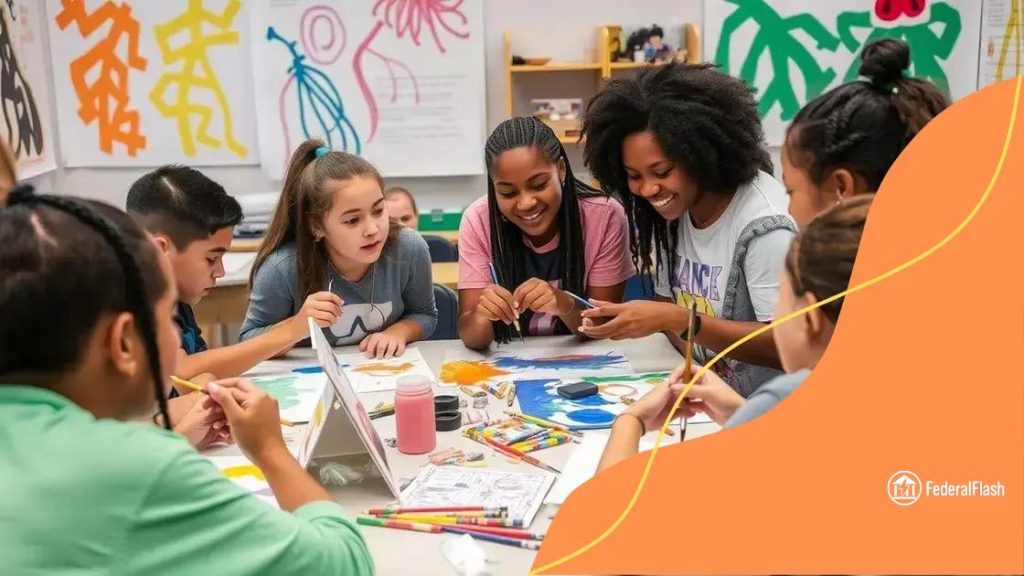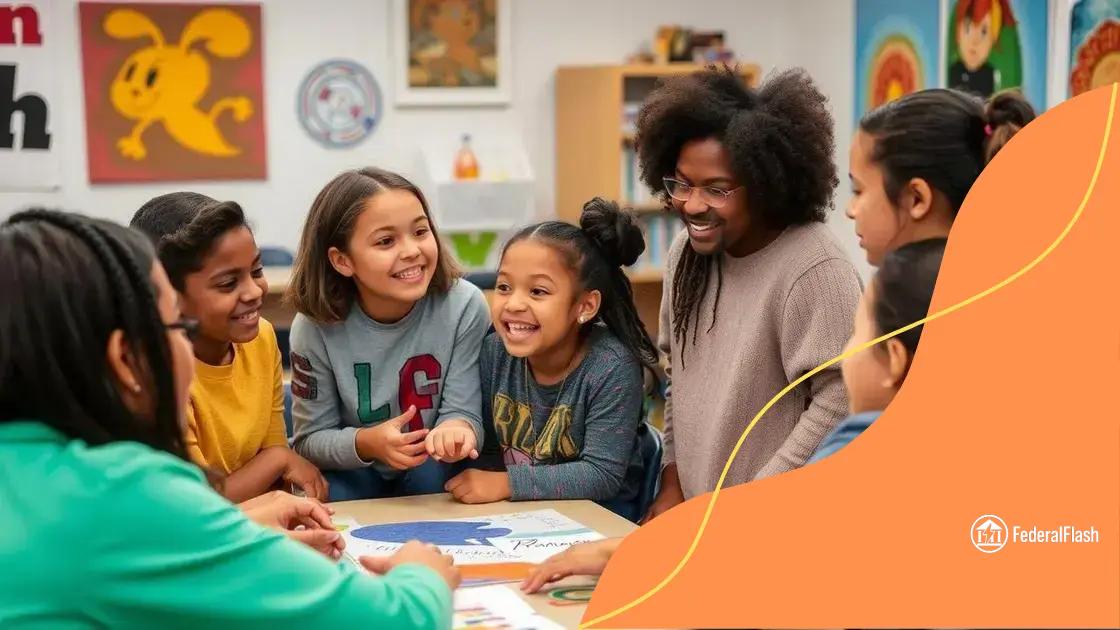The role of arts education in student development

Anúncios
The role of arts education in student development significantly boosts creativity, emotional intelligence, and academic performance, making it essential for fostering well-rounded individuals in today’s educational landscape.
The role of arts education in student development is often underestimated, yet it plays a crucial part in fostering well-rounded individuals. Have you considered how engaging in the arts can shape a student’s future?
Anúncios
Understanding the importance of arts education
Understanding the importance of arts education is essential for all students. It helps develop not only creativity but also critical thinking skills. When students engage in various art forms, they explore their emotions and express themselves in unique ways.
Benefits of Arts Education
Arts education provides several key benefits that shape a student’s development. These benefits include:
- Enhanced creativity: Participation in the arts helps students think outside the box.
- Improved academic performance: Studies show that students involved in arts programs often excel in other subjects.
- Stronger emotional skills: Engaging in the arts fosters empathy and emotional awareness.
- Collaborative skills: Group projects in arts educate teamwork and cooperation among students.
Additionally, when students participate in arts education, they can discover new passions and talents they may not have otherwise encountered. This exploration supports a well-rounded educational experience and prepares them for future opportunities.
Anúncios
Arts Education in Everyday Life
Integrating the arts into everyday life can make a significant difference. For example, schools can organize regular art classes, theater performances, and musical events. Students learn to appreciate different forms of artistic expression. This exposure not only enhances their skills but also builds confidence when sharing their work. Arts education nurtures individual voices while creating an environment where diversity is celebrated.
Teachers play a vital role in advocating for arts education. They can promote the importance of these programs to parents and school administrators. This advocacy ensures that students receive the benefits of creative learning throughout their education.
How arts education boosts creativity
Arts education plays a vital role in how students express their creativity. When children are exposed to arts, they learn to think differently and explore new concepts. This encourages imaginative thinking and unique problem-solving skills.
Encouraging Creative Thinking
One of the most important benefits of arts education is its ability to inspire creative thinking. Students learn to approach challenges from different angles. They explore various mediums, such as painting, music, and dance. This exploration fosters an open mind and allows for innovative ideas to emerge.
- Diverse techniques: Learning different art techniques enhances versatility in thinking.
- Experimentation: Arts education encourages students to experiment with their ideas, leading to unexpected solutions.
- Personal expression: Students can share their thoughts and feelings, enhancing self-awareness.
- Risk-taking: Engaging in the arts teaches students that taking risks is a part of the creative process.
Through hands-on activities, students can develop their skills and discover their passions. Working on projects allows them to explore their identity. This process not only boosts creativity but also helps build self-esteem.
The Connection to Other Subjects
Interestingly, the benefits of arts education extend beyond creativity. Studies show that students involved in the arts often perform better academically. For example, engaging in music can improve mathematical skills. Similarly, visual arts can enhance spatial awareness, which is important in science and engineering.
As students integrate art into their learning experiences, they begin to see connections between different subjects. This interconnectedness promotes critical thinking and helps them become more adaptable learners. By fostering creativity through arts education, students are better equipped for the diverse challenges they will face in the future.
The impact of arts education on emotional intelligence

The impact of arts education on emotional intelligence is profound and transformative. When students engage in the arts, they not only enhance their creativity but also nurture their emotional skills. This type of education allows them to recognize, understand, and manage their emotions effectively.
Enhancing Emotional Awareness
Through arts education, students learn to express their feelings in various ways. Whether it’s through painting, music, or dance, each art form offers a unique method of emotional expression. This engagement fosters a sense of empathy as they interpret emotions expressed by others, enhancing their ability to relate to peers.
- Recognizing emotions: Arts activities help students identify their own emotional responses.
- Understanding others: Collaborating on artistic projects encourages students to perceive others’ feelings and perspectives.
- Coping skills: Arts education provides healthy outlets for expressing emotions, reducing stress.
- Building confidence: Sharing their artistic creations boosts self-esteem and self-worth.
As students create and perform, they navigate a range of emotions. This process encourages them to reflect on their feelings and enhances their emotional vocabulary. When students articulate their thoughts, they better understand the significance of their emotional experiences.
Fostering Empathy and Social Skills
Arts education promotes empathy among students. When they engage in group projects or performances, they learn to listen and respond to each other’s ideas and feelings. This collaborative environment builds social skills essential for effective communication.
Moreover, students often discuss the themes and narratives in their artistic work. These discussions deepen their understanding of different cultures and perspectives, creating a sense of community. As they express their thoughts and feelings regarding art, they become more attuned to others’ experiences, fostering compassion and a stronger connection within their peer groups.
Integrating arts into the mainstream curriculum
Integrating arts into the mainstream curriculum is a powerful way to enhance educational experiences. When schools include arts education alongside traditional subjects, students benefit in numerous ways. This integration can inspire creativity and promote critical thinking across various disciplines.
Benefits of Integration
By weaving arts education into everyday learning, schools can create a rich environment where students thrive. This method encourages innovation and helps students connect concepts from different subjects.
- Improved engagement: Students are often more excited about learning when arts are involved.
- Enhanced understanding: Arts can help clarify complex subjects by presenting information visually or through performance.
- Greater retention: Students tend to remember lessons better when they relate them to artistic experiences.
- Development of diverse skills: Integrating arts fosters skills such as teamwork, communication, and problem-solving.
As students participate in art-related activities, they often develop a sense of ownership over their learning. This boost in motivation helps them tackle other subjects with enthusiasm. For example, using theater exercises can enhance public speaking skills in language arts classes.
Real-Life Applications
Schools can implement integrating arts by collaborating with local artists and cultural organizations. Workshops and projects can bring real-world experiences into the classroom, making learning more applicable. For instance, bringing in musicians to explore rhythms can tie into lessons on mathematics and patterns.
Moreover, project-based learning that incorporates art allows students to address real community issues. This hands-on approach encourages students to use their creative talents while also applying their academic knowledge. As a result, they become more invested in their education.
Success stories of arts programs in schools
Success stories of arts programs in schools showcase the transformative impact arts education can have on students and communities. Numerous schools have embraced arts initiatives, leading to improved student engagement, academic performance, and enhanced social skills.
Case Study: A School’s Art Revival
One inspiring example is a school that reinvigorated its arts program after facing declining enrollment. By incorporating various art forms such as painting, theater, and music, the school not only attracted new students but also increased attendance among current ones. Teachers reported a rise in motivation and creativity among students, resulting in higher grades in core subjects.
- Increased participation: More students joined art classes, eager to express themselves.
- Community involvement: Local artists and parents collaborated on projects, fostering a strong sense of community.
- Improved behavior: With increased focus and self-expression, student behavior in classrooms improved significantly.
These changes created a positive ripple effect in the school environment, fostering a culture that values creativity and collaboration.
Community Art Projects
Another successful approach involves schools partnering with community organizations to implement arts programs. For example, one district initiated a mural project where students, guided by local artists, designed and painted murals reflecting their community’s culture. This not only beautified the school but also instilled a sense of pride in students.
Students learned the importance of teamwork and communication while developing their artistic skills. Plus, the project culminated in a vibrant community event that brought families together and celebrated the students’ achievements. Such programs highlight the potential of arts education to strengthen both students and communities.
FAQ – Frequently Asked Questions about Arts Education
What are the main benefits of arts education in schools?
Arts education enhances creativity, improves emotional intelligence, and boosts academic performance, providing students with a well-rounded education.
How can arts programs impact student engagement?
Arts programs often increase student enthusiasm and motivation, making learning more enjoyable and relevant.
In what ways does arts education foster community involvement?
Arts initiatives often involve collaborations with local artists and organizations, creating connections between schools and their communities.
Can arts education be integrated with other subjects?
Yes, integrating arts with subjects like math and science can enhance understanding and retention while promoting critical thinking.